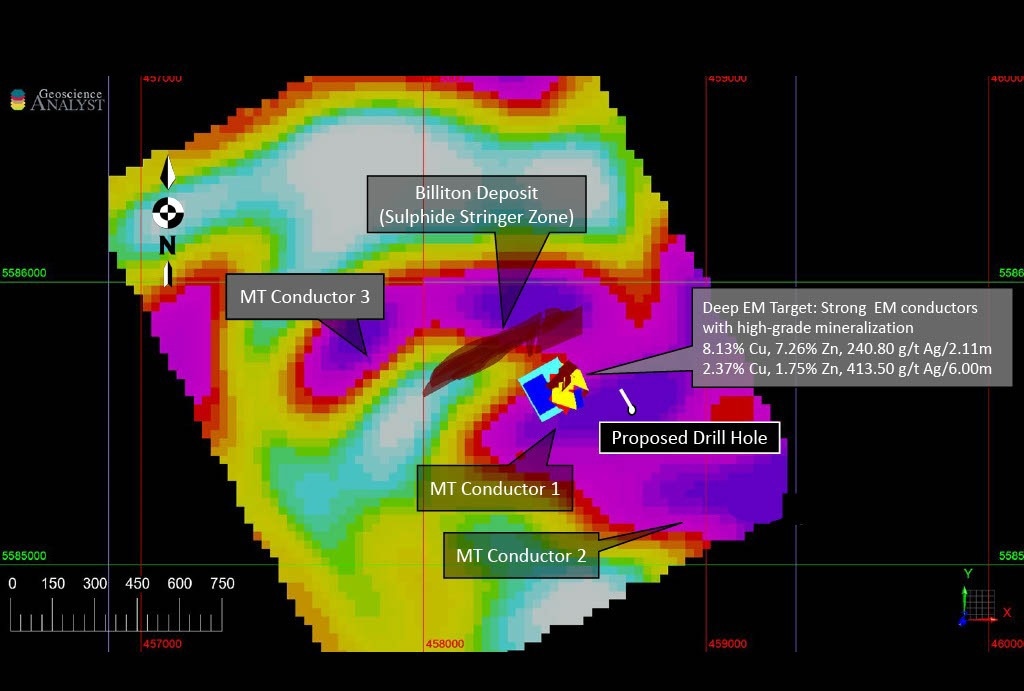Copper Lake Resources Ltd. reported that diamond drilling has begun on its Marshall Lake Zn-Cu-Ag VMS project in Northwestern Ontario. Helm Diamond Drilling Ltd. of Binche, British Columbia, is completing the drilling using a Discovery 2 fly diamond drill rig.
 Plan map of the MT conductors (500 metres below surface) showing Billiton Stringer Zone and Deep EM target and associated high-grade Cu-Zn-Ag stringer mineralization. Image Credit: Copper Lake Resources Ltd.
Plan map of the MT conductors (500 metres below surface) showing Billiton Stringer Zone and Deep EM target and associated high-grade Cu-Zn-Ag stringer mineralization. Image Credit: Copper Lake Resources Ltd.
During the current campaign, diamond drilling will focus on two key target locations, including the Deep EM target, a notable magneto-telluric (MT) conductor located proximal to and under high-grade zinc-copper silver stringer mineralization. The second drill target is an EM conductor located 2 km east of the Billiton deposit.
MT Targets
The magnetotelluric method is a geophysical technique that employs naturally occurring electromagnetic fields (EM) to determine the earth’s electrical conductivity. MT conductors indicate the presence of metallic sulfide deposits to depths of up to 1,000 m, well exceeding the depths of previous geophysical observations at Marshall Lake.
In July 2021, SJ Geophysics Ltd., a Delta, British Columbia-based company, finished the MT survey. To identify deep drill prospects, the company had the MT data evaluated and modeled. The survey was finished at the Deep EM target, which the company drilled in 2021 and 2022 and produced high-grade intercepts, including:
- 8.13% Cu, 7.26% Zn, 240.80 g/t Ag & 0.33 g/t Au over 2.11 m
- 5.81 % Cu, 7.32% Zn, 171.20 g/t Ag & 0.02 g/t Au over 1.95 m
- 2.37% Cu, 1.75% Zn, 413.15 g/t Ag & 0.37 g/t Au over 6.00 m
The mineralization in the stringer-style is located around 300 meters below the surface. To expand on the VMS mineralizing system’s boundaries and size potential, the MT survey was commissioned to look for conductors representing extensions to the discovered stringer and/or massive sulfide mineralization to depths of up to 1,000 m.
Three strong conductors, high-grade stringers or feeder zones located close to the Deep EM target and Billiton deposit, were identified by 3D modeling. It is believed that all three of the MT conductors have a high potential for the existence of a large sulfide deposit nearby. No diamond drilling test has been performed on any of the MT conductors.
Given its close relationship to bore-hole electromagnetic (BHEM) conductors and accompanying high-grade stringer mineralization, centered 300 meters below the surface (collectively the Deep EM Target), MT Conductor 1 is the conductor with the greatest priority for drilling.
The top portion of MT Conductor 1 most critically continues its downslope dip to the southeast to a depth of about 1,000 m, closely aligning with the BHEM plates and mineralization.
Based on the available geological and geophysical data, it is possible that MT Conductor 1 is a deeper reflection of the previously reported downslope extension of the high-grade stringer mineralization.
The location is now being cleared and cribbed to provide access to MT Conductor 1 for the drill rig. Within the following three to four days, the drill is expected to be on-site and conducted. The Discovery 2 fly drill rig can drill to a depth of 750 m, turning NQ-size rods, and the hole is likely to be completed to at least that depth.
Build-Up Conductor Target
Abitibi Geophysics has conducted a large-loop electromagnetic survey (LLEM) that thoroughly delineated an intriguing electromagnetic conductor known as the Build-Up Conductor. The conductor, in younger rocks, lies about 2 km east of the Billiton deposit in an undrilled region of the Marshall Lake property. The modeled conductor measures 500 m by 150 m and has moderately strong conductivity.
A single drill hole (MAR-24-01) was used to test the conductor. The hole cut through a thick succession of altered volcanic rocks intruded by gabbro sills. In volcanic and intrusive lithotypes, weak to moderate chloritization, silicification, and potassic alteration occur in high-grade metamorphic rocks.
The rock types contain disseminated magnetite, patchy and net-textured pyrrhotite, and pyrite over substantial widths. The presence of magnetite, pyrrhotite, and pyrite has been proposed to explain the existence of the conductor.
In the upcoming days, the core’s mineralized and altered portions will be sampled. As soon as the assay results are available, they will be shared.